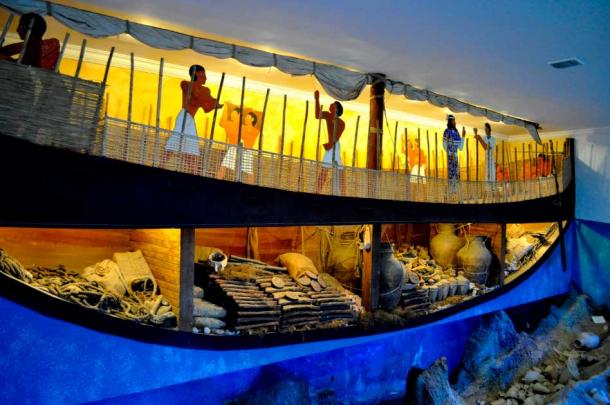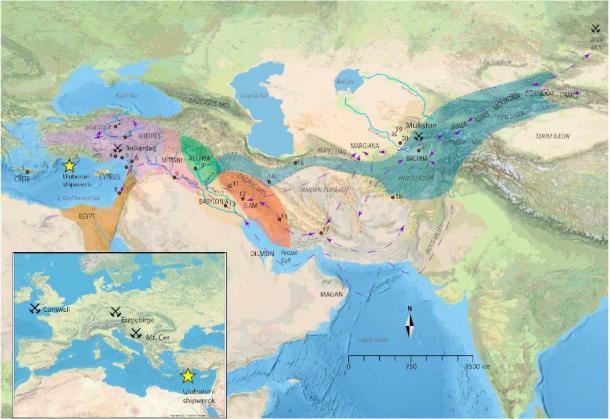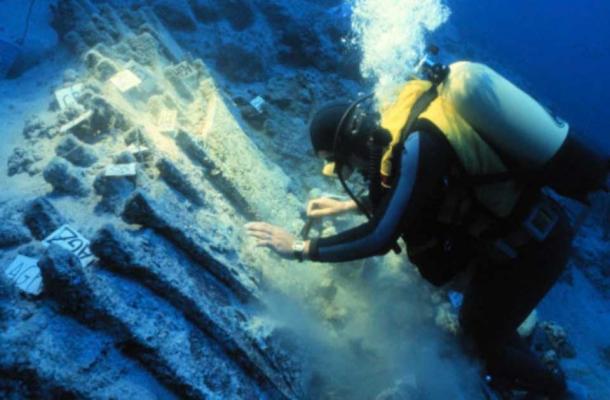
Uluburun Shipwreck: New Study Traces the Tin that Forged Empires
The iconic and historic Uluburun shipwreck has revealed fascinating insights into complex ancient trade networks, according to a brilliant new study. The Mediterranean shipwreck off the coast of present-day Turkey was discovered in 1982, carrying tons of rare metals, in fact, the largest Bronze Age collection of raw metals ever found. Part of this shipment included tin, a coveted material on its way to become bronze.
The ill-fated ship, laden in luxury cargo, was likely bound for a Mycenaean palace in mainland Greece. In addition to raw materials, it contained gifts, swords, daggers, metal ingots, and semi-precious stones!

Full-size replica of the Uluburun shipwreck, in St. Peter's Castle, Bodrum, Turkey (Panegyrics of Granovetter / CC BY SA 2.0)
Central Asian Highland Communities: Producers and Suppliers of Tin
The new study in the Sciences Advances journal has revealed some intriguing details about this trade network, as well as some surprises. A third of the tin found aboard the 14th century BC shipwreck was produced and supplied by small communities of highland pastoralists from present-day Uzbekistan in Central Asia, revealing important facets about the social and political landscape that dominated the late Bronze Age.
- The Legacy of Armenia: Trade, Metallurgy, and Forging of Precious Metals of the Ancient World
- Surprise Discovery That Ancient Tin Ingots Found in Israel Came From England

Map of regional geography and main sites - Purple dashed arrows depict documented trade networks, circa 2200 to 1700 BC. Blue shaded region reflects the corridor connecting the Anatolian and Central Asian/Middle Eastern tin trade, circa 1600 to 1000 BC. Other shaded areas represent key Late Bronze Age polities. Inset map illustrates the location of ancient tin sources in Europe. (Michael Frachetti)
The research team was assisted by advances in geochemical analyses, enabling researchers to determine the origins of the tin with high-level certainty. “When I first saw pictures of the ship, I saw it as an amazing opportunity to use my isotope science to trace metal sources,” said Juniata College professor of geology Ryan Mathur, a member of the research team.
To their surprise, the tin originated from a prehistoric mine in Uzbekistan, which was over 2,000 miles (3,200 kilometers) from Haifa, where the cargo had been loaded. Who moved this heavy cargo across some of the most rugged terrain known to man, all the way through valleys and mountains that experienced the extremes of desert-like temperatures?
According to a press release, the answer was small-scale communities or free laborers, who lay outside the purview of kings, emperors, or any other political force. On top of that, at the time, the passes between Iran and Mesopotamia did not have any central authority, major industrial center, or empire.
Michael Frachetti, professor of archaeology in Arts & Sciences at Washington University in St. Louis, and a co-author of the study, explained, “It appears these local miners had access to vast international networks and — through overland trade and other forms of connectivity — were able to pass this all-important commodity all the way to the Mediterranean. It’s quite amazing to learn that a culturally diverse, multiregional and multivector system of trade underpinned Eurasian tin exchange during the Late Bronze Age.”

Uluburun shipwreck excavation showing copper oxhide ingots (Cemal Pulak/Texas A&M University)
Tracing Tin: Trade Networks before the Silk Road
At this time period in history, the tin ingots used in manufacturing bronze were the crucial element upon which entire empires could be conquered or defended, Discover Magazine reported. To put this into context, the researchers estimate that the tin onboard this shipwreck could have supplied enough to manufacture 5,000 ancient swords.

Examples of the ingots recovered from the Uluburun shipwreck (Panegyrics of Granovetter / CC BY SA 2.0)
Bronze weaponry was vital to sustain empires founded on warfare and conquest, and by 1500 BC, it had become the “high technology” of the Eurasian region. However, historians and archaeologists were unable to determine the origin of ancient tin. Bronze’s other alloy, copper, had numerous documented historical mining sites. However, no proof of tin mining appeared, although conjecturing pointed to Turkey; Cornwall, England; Germany; and Tajikistan. There were also murmurs that suggested Central Asia, but conclusive evidence was not forthcoming.
“Everyone thought tin came from some exotic place in Central Asia, but the source was never specified,” said K. Aslihan Yener, of the Institute for the Study of the Ancient World at New York University (ISAW).
The research team conducted a comprehensive round of isotope analysis, supported by Cemal Pulak of Texas A&M University, who had maintained samples of the tin ingots for decades. Approximately 1,500 samples were studied, including 1,000 bronze and tin artifacts, along with 425 tin ores from around the world. This allowed the researchers to determine the origin of the mined tin.
While two-thirds of the tin ingots came from Turkey, the remainder proved to be from Central Asia. This implies that robust trade networks existed and thrived, which preceded the fabled Silk Road. These networks were constantly provided tin through decentralized small-scale mining, which was then sent to a central point for processing. The trade network likely consisted of nomads, herders, and pastoralists, who adapted differently to the needs of the trade.
“I think this has been the most exciting study of my career. The Uluburun shipwreck is iconic,” concluded Wayne Powell of Brooklyn College, who had collaborated with Mathur earlier on a tin and bronze study for over a decade. “It’s described in every study or analysis of ancient trade in the Mediterranean and is foundational to our understanding of large-scale commodity trading between the major Bronze Age kingdoms, including Egypt, Mycenae, and the Hittites of Anatolia.”
Top image: Reconstruction of the Uluburun shipwreck. Its recovered cargo is providing insight into vast Bronze Age trading networks. Source: Markus Studer / CC BY NC SA 2.0
By Sahir Pandey
References
Powell, W. et al. November 30, 2022. Tin from Uluburun shipwreck shows small-scale commodity exchange fueled continental tin supply across Late Bronze Age Eurasia. Sciences Advances, 8(48). Available at: DOI: 10.1126/sciadv.abq3766.
Savat, S. November 30, 2022. Findings from 3,000-year-old Uluburun shipwreck reveal complex trade network. Washington University in St. Louis. Available at: https://source.wustl.edu/2022/11/findings-from-2000-year-old-uluburun-shipwreck-reveal-complex-trade-network/.
Walters, S. December 2, 2022. A 2,000-Year-Old Shipwreck Reveals Ancient Trade Routes. Discover Magazine. Available at: https://discovermagazine.com/the-sciences/a-2-000-year-old-shipwreck-reveals-ancient-trade-routes.
















Comments
Was it trade or was it theft by invading armies? We know both were happening. I’d lean toward theft.
Nobody gets paid to tell the truth.